 猛戳!跟哥们一起玩蛇啊 👉 《一起玩蛇》🐍 =
猛戳!跟哥们一起玩蛇啊 👉 《一起玩蛇》🐍 =

💭 写在前面: 本篇是关于多伦多大学自动驾驶专业项目 Gym-CarRacing 的博客。GYM-Box2D CarRacing 是一种在 OpenAI Gym 平台上开发和比较强化学习算法的模拟环境。它是流行的 Box2D 物理引擎的一个版本,经过修改以支持模拟汽车在赛道上行驶的物理过程。由于内容比较多所以分多次更新,本篇是关于前置知识介绍,以及项目环境准备的。具体如下:
- 自动驾驶的背景知识介绍。
- 然后会讲解本项目可能所需的知识点,需要用到图像处理算法和基础车道线检测算法,这里的讲解并不会太细,读者如果对不熟悉可以在单独搜索,C站上也有不少介绍这些算法的博客。
- 项目所需的环境安装教程(这个部分是我在博客审阅阶段临时增添的),因为该项目需要 Conda 和 gym 环境和一堆必不可少的软件包(少一个都跑不了)。我看了网上有不少朋友在做该项目时,在环境安装上踩了不少坑。所以为了方便需要做该项目的同学、对该项目感兴趣的朋友,我这里准备了环境安装的教程。
🔗 多伦多大学自动驾驶专项课程:Motion Planning for Self-Driving Cars | Coursera
🔗 Gym Car Racing 文档:Car Racing - Gym Documentation
 本篇博客全站热榜排名:4
本篇博客全站热榜排名:4
Ⅰ. 背景知识介绍
0x00 引入: 什么是自动驾驶?
" Autonomous(自动)+ driving(驾驶) "
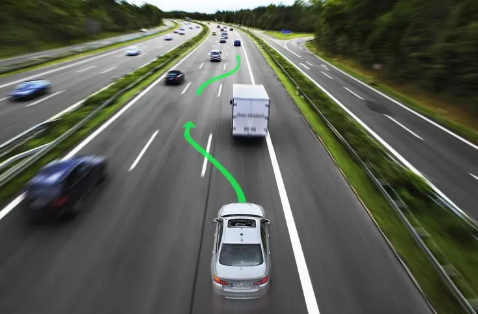 自动驾驶,即汽车自主认知周边环境并安全行驶的技术。
自动驾驶,即汽车自主认知周边环境并安全行驶的技术。
Self-driving car, autonomous vehicle, driver-less car, or robotic car……
0x01 自动驾驶的基本组件
- 汽车(Car):实际移动的车辆,代理人应该控制它
- 传感器(Sensors):探测周围环境的设备
- 代理人(Agent):一个在给定的周围环境中安全地驱动 var 的物体
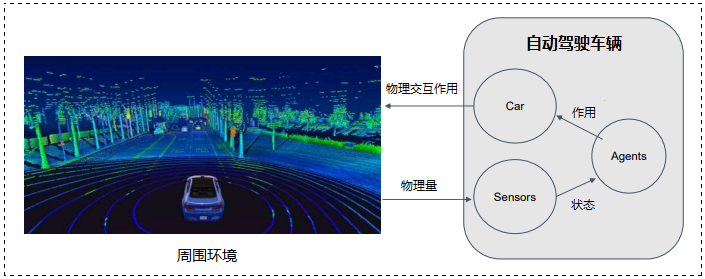
传感器(Sensors on self-driving cars):
- 460 个激光雷达摄像机、RGB 摄像机
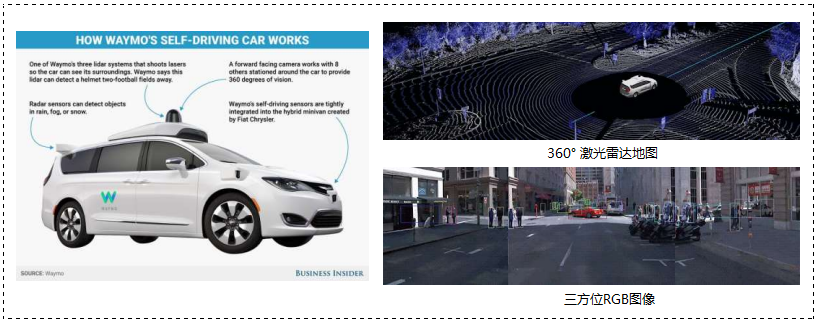
自动驾驶的目标(Goal of Autonomous Driving):
- 在给定的情况下的安全驾驶
- 根据给定的情况 (state) 安全驾驶汽车
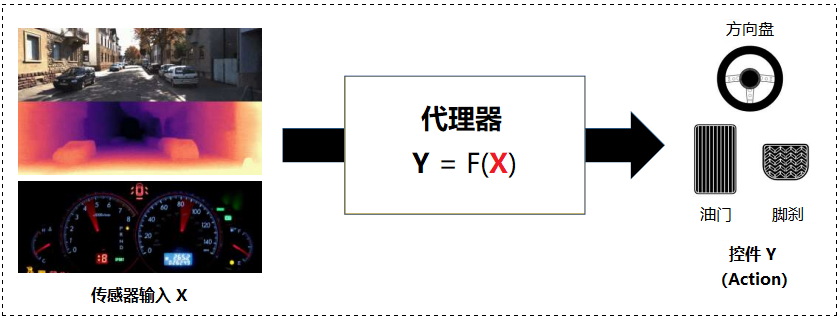
映射函数:Sensor Input → Action
- 模块化管线(modular Pipelines)
- 端到端训练(End-to-End Learning)
- 直接感知(Direct Perception)
0x02 模块化组件(Modular Pipeline)

每个模块连接下一个模块的输入:低级感知、场景解析、路径训练、车辆控制。
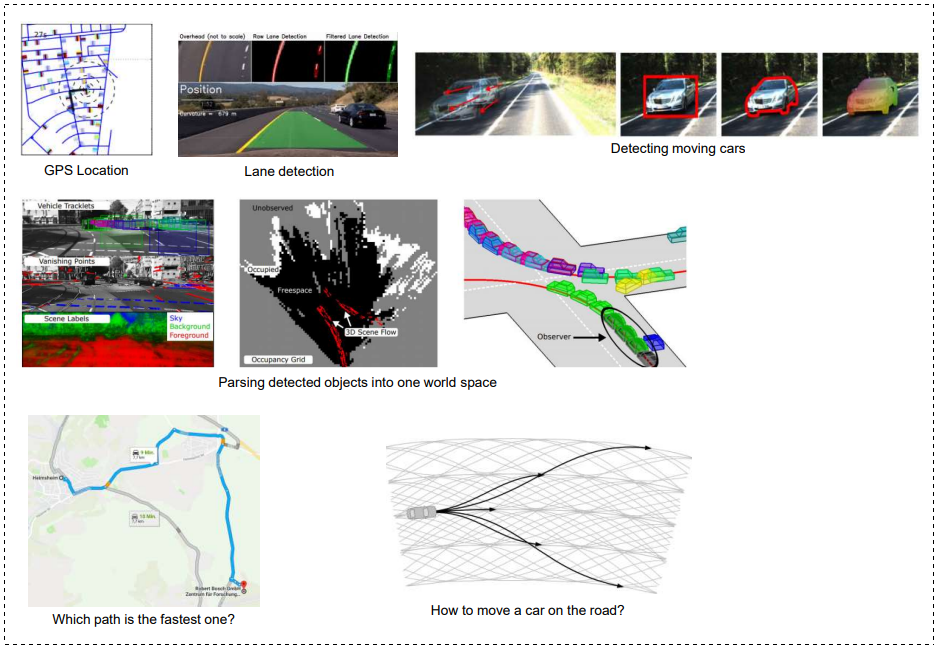
❓ 需要思考的问题:为遵循选定的路径,我们应将手柄转多少度?我们应该以什么速度前进?

Ⅱ. 前置知识
0x00 车道标记与车道检测(Lane marking & Lane detection)
- 使用梯度图或边缘过滤的图像,我们可以通过阈值处理来检测车道标记。
- 考虑在附近存在相反梯度的点。
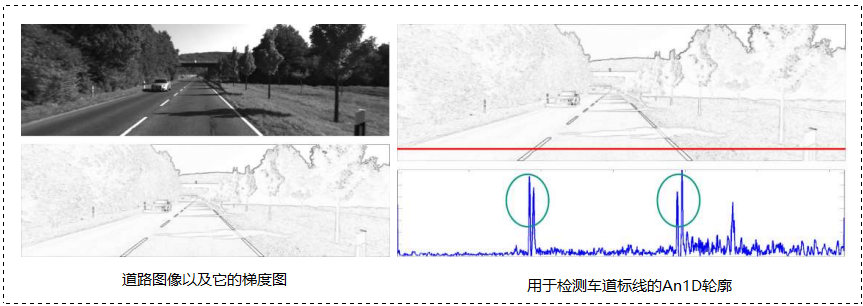
0x01 边缘检测(Edge Detection)
- 通过用边缘过滤器对图像进行卷积,得到两个方向的梯度图。
- 这里也可以使用其他的边缘核进行边缘检测。
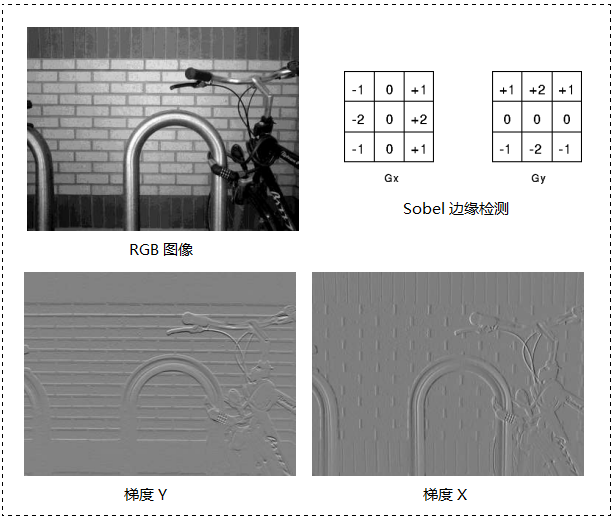
边缘检测是图像处理的一种常见技术,用于检测图像中的边缘和边界。这对于自动驾驶系统来说是非常重要的,因为边缘检测可以帮助系统识别道路、车辆、行人等重要物体。
通常边缘检测是通过使用边缘过滤器对图像进行卷积来实现的,边缘过滤器是一种特殊的卷积核,其中包含了两个方向的梯度图,可以检测出图像中的垂直和水平边缘。比如图中显示的 Sobel 过滤器,就可以得到一张图像的 方向和
方向的梯度图,其中
方向的梯度图可以检测出图像中的垂直边缘,
方向的梯度图可以检测出图像中的水平边缘。
除了 Sobel 过滤器之外,还有许多其他的边缘核可以用于边缘检测。比如 Canny 边缘检测算法,这是一种非常流行的边缘检测算法,它可以有效地消除噪声并提供清晰的边缘检测结果。
Canny 边缘检测是由 John F. Canny 在 1986 年提出的一种边缘检测算法。
它是一种多步骤的边缘检测算法,包括以下几个步骤:
- 图像高斯滤波:使用高斯滤波器对图像进行模糊处理,以减少噪声并使边缘更加明显。
- 计算图像梯度:使用 Sobel 过滤器或其他方法计算图像的梯度,并使用梯度的方向和大小来表示图像中的边缘。
- 非极大值抑制:使用非极大值抑制算法来去除图像中的假边缘。
- 双阈值检测:使用两个阈值来区分真正的边缘和假边缘。
- 边缘连接:将检测到的边缘连接起来,以形成完整的边缘。
Canny 边缘检测算法的优点是它能够有效地消除噪声,并提供清晰的边缘检测结果。但是,由于它是一种多步骤的算法,所以它的计算复杂度较高,不太适用于实时边缘检测场景。
0x02 IPM 逆透视变换(Inverse Perspective Mapping)
IPM(Inverse Perspective Mapping)是一种图像处理技术,它可以将一张透视变换后的图像进行逆变换,使其看起来像是从俯视角度拍摄的。这对于自动驾驶系统来说非常重要,因为它可以帮助系统更准确地识别道路、车辆、行人等物体。
- 在通常情况下,道路是在平面上的。
- 如果三维变换是已知的,我们就可以将道路图像投射到地面平面上。
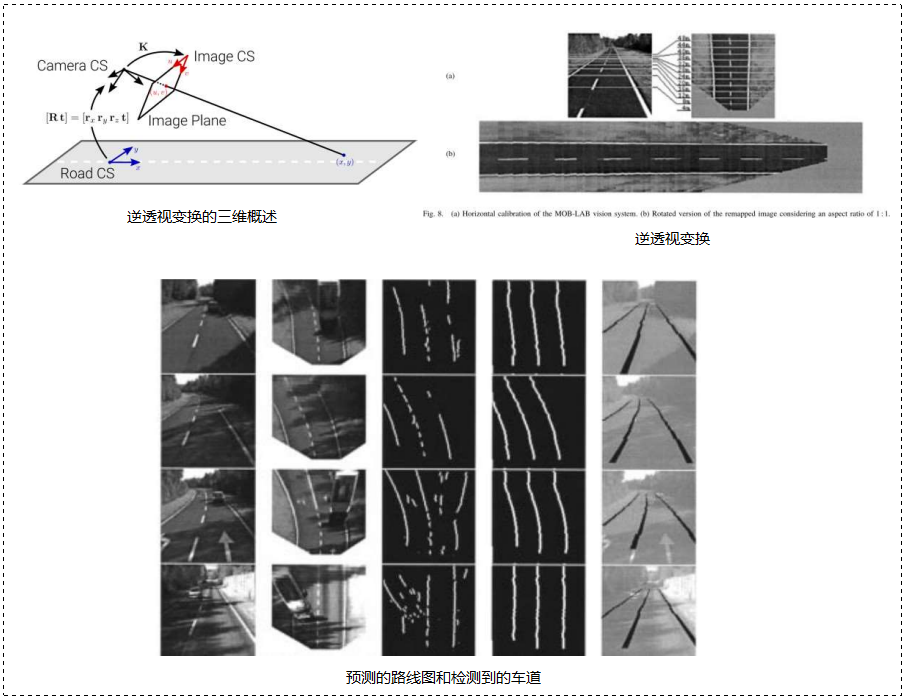
0x03 车道线检测:参数化车道标线估算(Parametric Lane Marking Estimation)
为了给汽车导航,我们需要将检测到的标记像素与一个更有语义的曲线模型与之相匹。
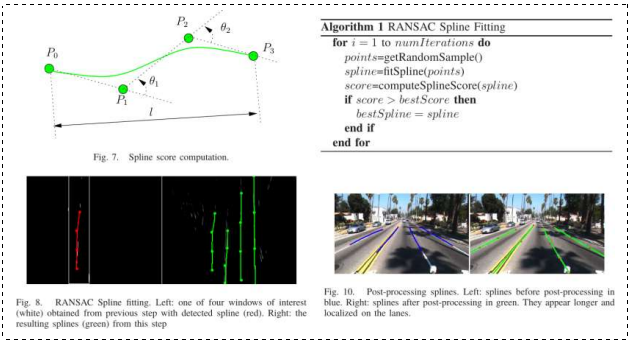
0x04 贝塞尔曲线(Bezier Curve)
贝塞尔曲线(Bézier curve)是一种数学曲线,贝塞尔曲线常用于计算机图形学中,因为它们可以用于创建平滑的曲线和图形。贝塞尔曲线是通过控制点来描述曲线形状的,其中一个或多个控制点用于指定曲线的形状。
贝塞尔曲线可以通过控制点的位置来控制曲线的形状,并可以通过改变控制点的位置来改变曲线的形状。这使得贝塞尔曲线非常适用于创建复杂的曲线和图形。
- 一个由控制点定义的多项式曲线

0x05 线性贝塞尔曲线(Linear Bezier Curve)
线性贝塞尔曲线是一种特殊的贝塞尔曲线,它由两个控制点和一个起始点和一个终止点组成。线性贝塞尔曲线是最简单的贝塞尔曲线之一,它可以用来描述直线。线性贝塞尔曲线的方程:
其中, 是贝塞尔曲线上的点,
是参数,
和
是控制点。
- 类似线性插值法(linear interpolation)

0x06 二次贝塞尔曲线(Quadratic Bezier Curve)
由一个起始点、一个终止点和两个控制点组成。二次贝塞尔曲线是一种二次方程,可用来描述曲线和复杂的形状。二次贝塞尔曲线的方程:
其中, 是贝塞尔曲线上的点,
是参数,
是控制点。
- 两个线性内插点的内插
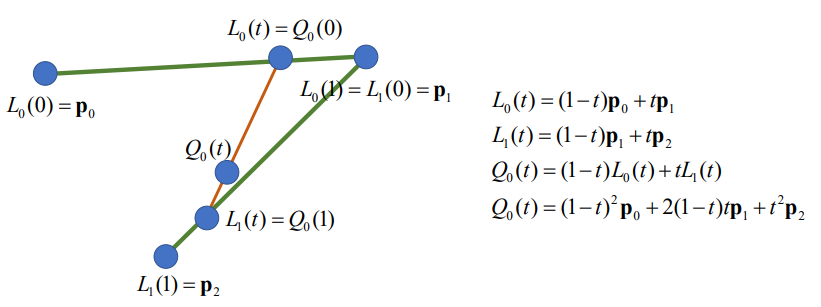
0x07 三次贝塞尔曲线(Cubic Bezier Curve)
由一个起始点、一个终止点和三个控制点组成。三次贝塞尔曲线是一种三次方程,它可以用来描述曲线和复杂的形状。三次贝塞尔曲线的方程:
其中, 是贝塞尔曲线上的点,
是参数,
是控制点。
- 二次点的插值
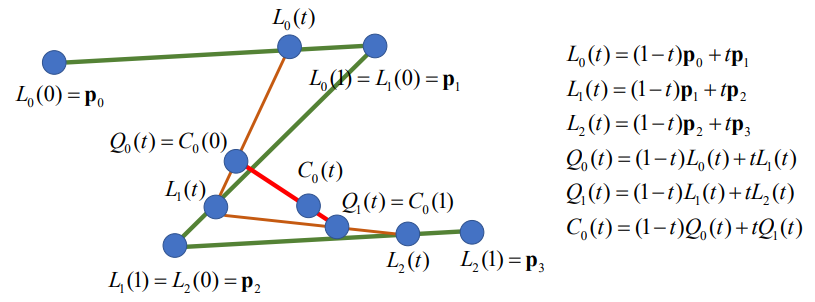
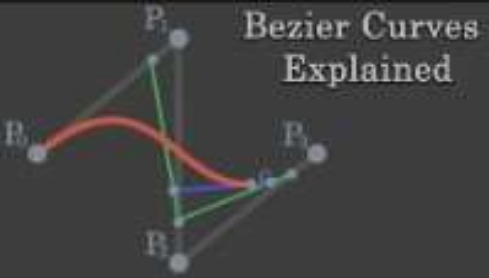
0x08 B样条曲线(B-Spline Curve)
B样条曲线是通过一系列的控制点来描述曲线形状的,这些控制点可以用来指定曲线的形状。B样条曲线通常使用 B样条曲线方程来描述,这是一个多项式方程。B样条曲线有许多不同的类型,包括二次B样条曲线、三次B样条曲线和四次B样条曲线。
已知 个控制点
,可定义
次 B 样条曲线的表达式为:
由控制点列表和程度定义的曲线,一条单片多项式曲线(它不同于与贝塞尔曲线)。
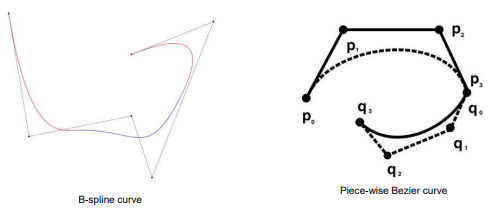
Ⅲ. 项目所需环境准备
0x00 前言
我默认读者已经安装了 Python,这里简单讲一下如何安装 Conda 和 gym。网上的资料很多,与之相比,我写的安装教程可能远没有那些专门安装环境的文章细致。我这里只是做简单介绍,旨在方便大家能快速准备好环境,能让程序正常跑起来的。因为我看了网上有不少人在做该项目时,在环境安装上踩了不少坑,很是让人头疼。所以这里我准备了 Conda 和 gym 环境安装的教程。
0x01 Step1:Python 开发环境设置 —— 安装 Conda
操作系统以 Window 为准进行说明(Linux 同理)
安装 Anaconda 或 Miniconda:
- Python 开发环境平台
- 支持各种环境设置与环境的更改
- https://docs.conda.io/en/latest/miniconda.html
- 有关安装方法和详细信息,请参阅百度

Step1:打开安装包后会进入欢迎界面,点击 Next>

Step2:许可协议界面,选择同意:

Step3:看情况选择,我们选择 Just Me:
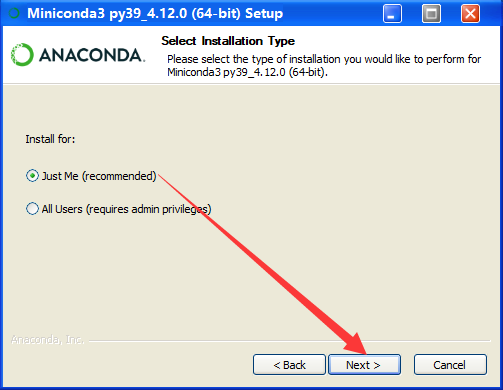
Step4:选择安装路径,默认是在 C 盘下的,点击 Browse 按钮可呼出窗口更换路径:
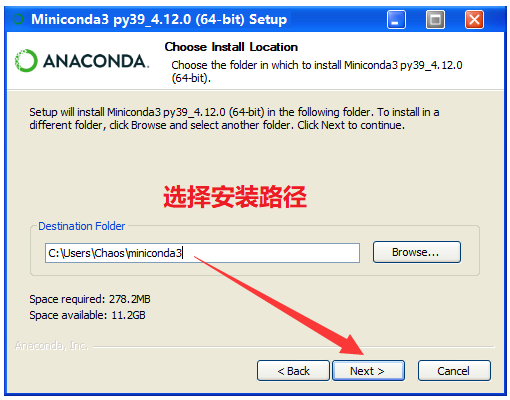
Step5:这里全部勾选
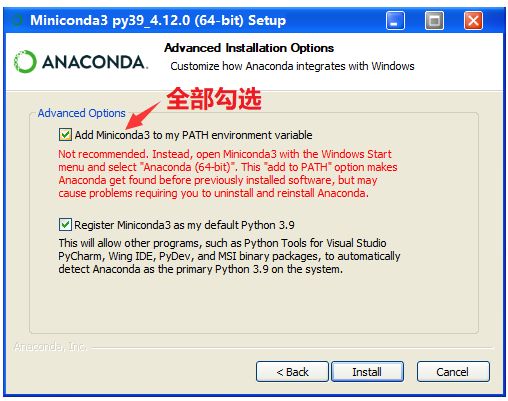
Step6:等待即可,可能有点慢,但是绝对没有 Vivado 慢!安装完毕后点击 Next >
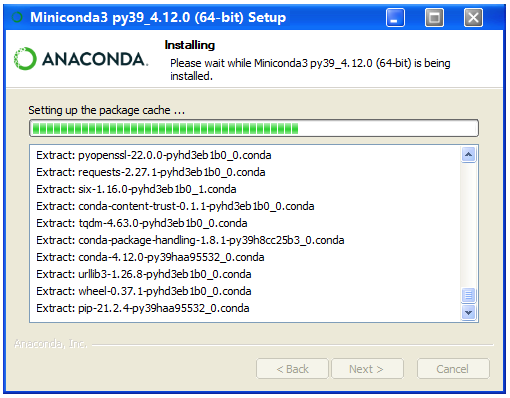
Final Step:点击 Finish
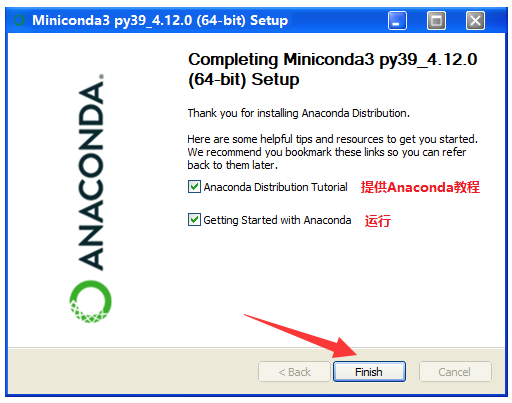

0x02 Step2:Conda 安装完毕后的环境设置
通过命令行操作,设置环境并激活即可:
🔍 官方说明:Managing environments — conda
详细查阅 Creating and activating an environment 部分。
安装命令示例:
- > conda env create –n autodriving
- > conda activate autodirving
- > conda install python
- > pip install pytorch
Step1:打开命令提示符,快捷键 Win+R 输入 cmd 后回车:
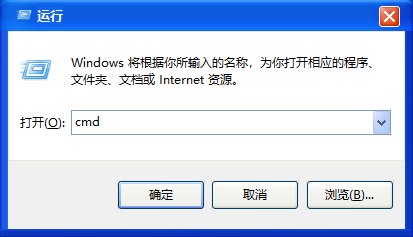
Step2:检查是否安装正常,在 cmd 中输入 conda
conda
没问题:
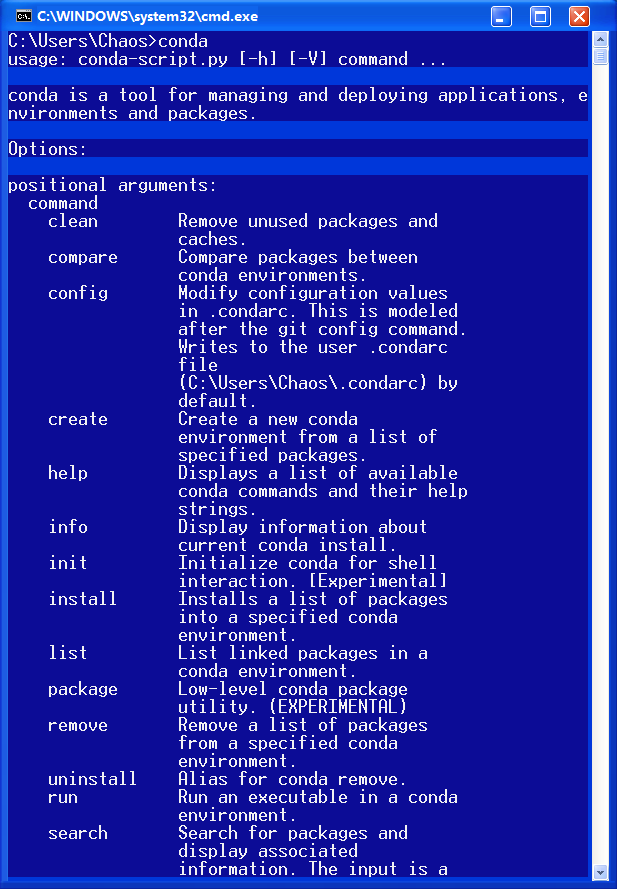
Step3:打开命令行下输入:
conda create -n python=2.7 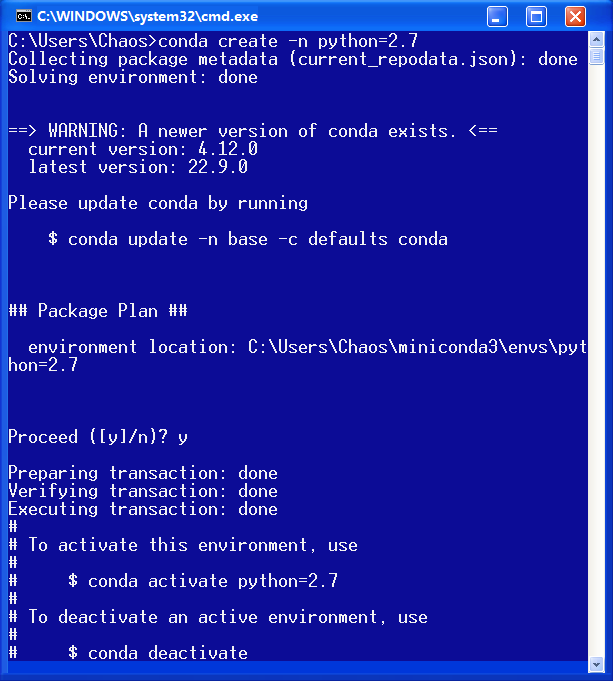
Step4:进入环境内部
conda activate [文件名]
0x03 关于 OpenAI GYM 的介绍
强化学习框架(https://github.com/openai/gym)
- 开源提供多种游戏环境。
- 本项目将使用 box2d-carracing
- 参考资料:https://www.gymlibrary.dev/

0x04 安装练习所需的软件包
- 下载解压文件后自行解压。
- 显示命令窗口后设置 Conda 环境。
- 找到到解压缩文件夹后执行以下命令:
- cd 到 /envs/box2d,python car_racing 执行 py 命令,确保 Acttion 没问题(方向键可以移动汽车就行)。
CarRacing 环境基本代码示例:
- gym.make() 环境配置。
- env.reset() 设置初始变量。
- env.step(action) 执行动作并返回以下观察值、补偿、是否结束。
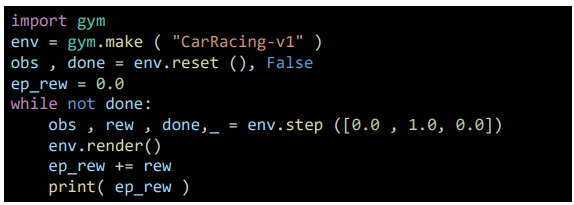
0x05 设置 GYM 环境
Step1:打开命令窗口设置准备 Conda
创建项目文件夹: conda create -n gym python=3.8
这里我去名为 3.8
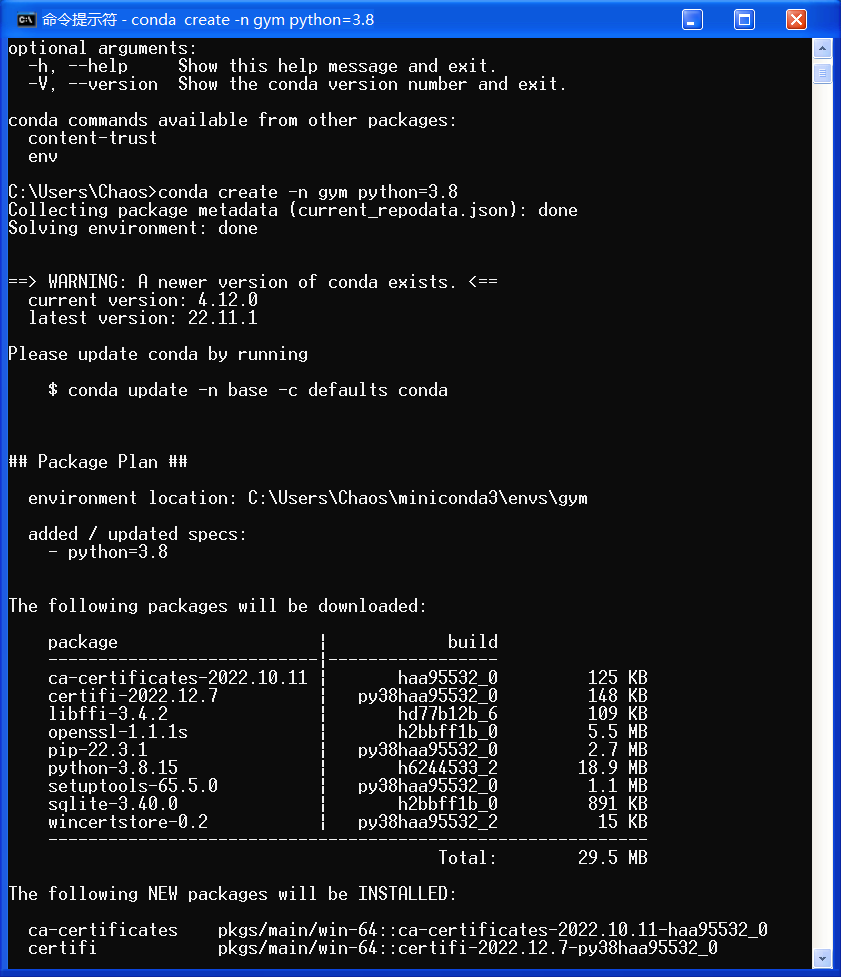
稍等片刻,会问你 yes 还是 no,我们输入 y 即可:
之后会开始提取安装包,耐心等待……
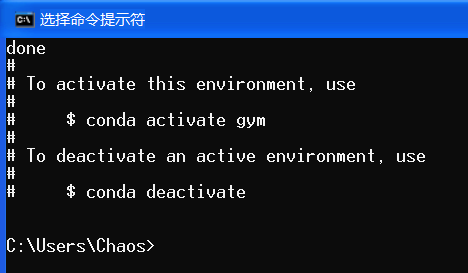
之后输入 conda activate gym 进行激活:
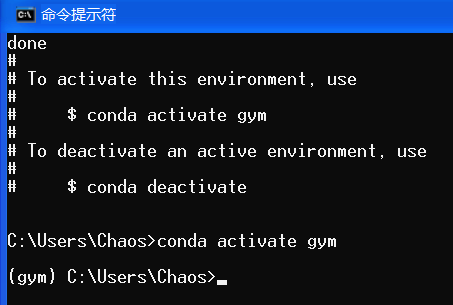
Step2:cd 至解压的文件夹位置
cd {{installed gym path}}我们是把 gym 解压到桌面的,我们 cd 过去即可。
Step3:输入下列指令
- pip install -e .[box2d]
- pip install matplotlib
- pip install scipy
- pip install pyglet
- pip install pygame
挨个安装即可:
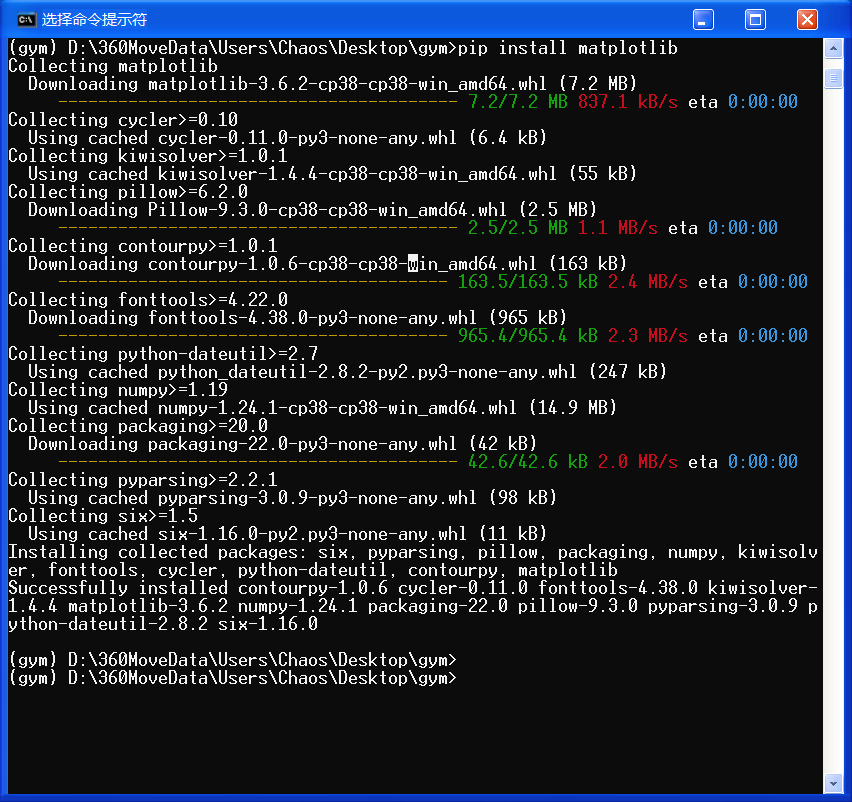
如果显示安装失败,可能是因为 python无法识别安装的版本,导致 pip install Box2D 显示无法安装,可以尝试输入以下指令安装:
python -m pip install Box2D全部安装完毕后,跳转到 gym/envs/box2d,运行 python car_racing.py 命令测试环境:
cd gym/envs/box2d(注意,gym 文件夹还有一个 gym 文件夹)
然后输入 python car_racing.py 运行,如果正常运行,就说明环境装好了。
🚩 运行效果如下:

至此,环境已全部准备完毕!
有些人开了就不会关了,很尴尬…… 建议直接强制关机 23333(滑稽)
拉闸!简单粗暴,一步到位!!!优雅,永不过时。
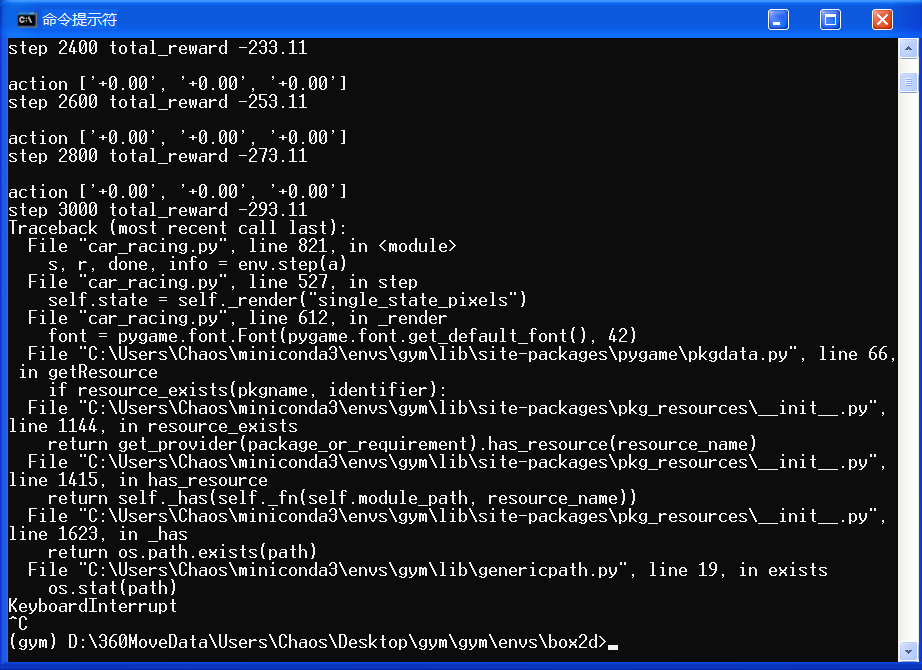
Ⅳ. 项目准备
0x00 实验说明:Box2D CarRacing 的 lane_dection
🚩 实践目标:实现一个模块化组件框架,落实简化版的模块化流水线。了解基本概念,并积累开发一个简单的自驱应用程序的经验。
🔨 环境选用:OpenAI GYM
- https://www.gymlibrary.ml/
- 我们将基于 Box2D CarRacing 实现,Box2D CarRacing 基本信息如下:
- Action:转向、加速、刹车
- Sensor input:
屏幕(显示汽车的状态和路径信息)

📜 尝试:
- 为汽车上方的部分找到一个好的裁剪,一个好的方法来分配车道边界的边缘,一个好的梯度阈值和样条平滑度的参数选择。
- 尝试找到失败的案例。

* 提供基础框架,只需要在 TODO 位置填写代码即可!
我就不提供资源下载链接了,直接手动吧:首先在桌面上创建一个文件夹,我们取名 skeleton ,然后创建出如下名称的 py 文件,将代码 CV 进去。
- lane detection.py
- import numpy as np
- import matplotlib.pyplot as plt
- from scipy.signal import find_peaks
- from scipy.interpolate import splprep, splev
- from scipy.optimize import minimize
- import time
-
-
- class LaneDetection:
- '''
- Lane detection module using edge detection and b-spline fitting
- args:
- cut_size (cut_size=65) cut the image at the front of the car
- spline_smoothness (default=10)
- gradient_threshold (default=14)
- distance_maxima_gradient (default=3)
- '''
-
- def __init__(self, cut_size=65, spline_smoothness=10, gradient_threshold=14, distance_maxima_gradient=3):
- self.car_position = np.array([48,0])
- self.spline_smoothness = spline_smoothness
- self.cut_size = cut_size
- self.gradient_threshold = gradient_threshold
- self.distance_maxima_gradient = distance_maxima_gradient
- self.lane_boundary1_old = 0
- self.lane_boundary2_old = 0
-
-
- def cut_gray(self, state_image_full):
- '''
- ##### TODO #####
- This function should cut the image at the front end of the car (e.g. pixel row 65)
- and translate to gray scale
- input:
- state_image_full 96x96x3
- output:
- gray_state_image 65x96x1
- '''
-
- return gray_state_image[::-1]
-
-
- def edge_detection(self, gray_image):
- '''
- ##### TODO #####
- In order to find edges in the gray state image,
- this function should derive the absolute gradients of the gray state image.
- Derive the absolute gradients using numpy for each pixel.
- To ignore small gradients, set all gradients below a threshold (self.gradient_threshold) to zero.
- input:
- gray_state_image 65x96x1
- output:
- gradient_sum 65x96x1
- '''
-
-
- return gradient_sum
-
-
- def find_maxima_gradient_rowwise(self, gradient_sum):
- '''
- ##### TODO #####
- This function should output arguments of local maxima for each row of the gradient image.
- You can use scipy.signal.find_peaks to detect maxima.
- Hint: Use distance argument for a better robustness.
- input:
- gradient_sum 65x96x1
- output:
- maxima (np.array) shape : (Number_maxima, 2)
- '''
-
- return argmaxima
-
-
- def find_first_lane_point(self, gradient_sum):
- '''
- Find the first lane_boundaries points above the car.
- Special cases like just detecting one lane_boundary or more than two are considered.
- Even though there is space for improvement ;)
- input:
- gradient_sum 65x96x1
- output:
- lane_boundary1_startpoint
- lane_boundary2_startpoint
- lanes_found true if lane_boundaries were found
- '''
-
- # Variable if lanes were found or not
- lanes_found = False
- row = 0
-
- # loop through the rows
- while not lanes_found:
-
- # Find peaks with min distance of at least 3 pixel
- argmaxima = find_peaks(gradient_sum[row],distance=3)[0]
-
- # if one lane_boundary is found
- if argmaxima.shape[0] == 1:
- lane_boundary1_startpoint = np.array([[argmaxima[0], row]])
-
- if argmaxima[0] < 48:
- lane_boundary2_startpoint = np.array([[0, row]])
- else:
- lane_boundary2_startpoint = np.array([[96, row]])
-
- lanes_found = True
-
- # if 2 lane_boundaries are found
- elif argmaxima.shape[0] == 2:
- lane_boundary1_startpoint = np.array([[argmaxima[0], row]])
- lane_boundary2_startpoint = np.array([[argmaxima[1], row]])
- lanes_found = True
-
- # if more than 2 lane_boundaries are found
- elif argmaxima.shape[0] > 2:
- # if more than two maxima then take the two lanes next to the car, regarding least square
- A = np.argsort((argmaxima - self.car_position[0])**2)
- lane_boundary1_startpoint = np.array([[argmaxima[A[0]], 0]])
- lane_boundary2_startpoint = np.array([[argmaxima[A[1]], 0]])
- lanes_found = True
-
- row += 1
-
- # if no lane_boundaries are found
- if row == self.cut_size:
- lane_boundary1_startpoint = np.array([[0, 0]])
- lane_boundary2_startpoint = np.array([[0, 0]])
- break
-
- return lane_boundary1_startpoint, lane_boundary2_startpoint, lanes_found
-
-
- def lane_detection(self, state_image_full):
- '''
- ##### TODO #####
- This function should perform the road detection
- args:
- state_image_full [96, 96, 3]
- out:
- lane_boundary1 spline
- lane_boundary2 spline
- '''
-
- # to gray
- gray_state = self.cut_gray(state_image_full)
-
- # edge detection via gradient sum and thresholding
- gradient_sum = self.edge_detection(gray_state)
- maxima = self.find_maxima_gradient_rowwise(gradient_sum)
-
- # first lane_boundary points
- lane_boundary1_points, lane_boundary2_points, lane_found = self.find_first_lane_point(gradient_sum)
-
- # if no lane was found,use lane_boundaries of the preceding step
- if lane_found:
-
- ##### TODO #####
- # in every iteration:
- # 1- find maximum/edge with the lowest distance to the last lane boundary point
- # 2- append maximum to lane_boundary1_points or lane_boundary2_points
- # 3- delete maximum from maxima
- # 4- stop loop if there is no maximum left
- # or if the distance to the next one is too big (>=100)
-
- # lane_boundary 1
-
- # lane_boundary 2
-
- ################
-
-
- ##### TODO #####
- # spline fitting using scipy.interpolate.splprep
- # and the arguments self.spline_smoothness
- #
- # if there are more lane_boundary points points than spline parameters
- # else use perceding spline
- if lane_boundary1_points.shape[0] > 4 and lane_boundary2_points.shape[0] > 4:
-
- # Pay attention: the first lane_boundary point might occur twice
- # lane_boundary 1
-
- # lane_boundary 2
-
- else:
- lane_boundary1 = self.lane_boundary1_old
- lane_boundary2 = self.lane_boundary2_old
- ################
-
- else:
- lane_boundary1 = self.lane_boundary1_old
- lane_boundary2 = self.lane_boundary2_old
-
- self.lane_boundary1_old = lane_boundary1
- self.lane_boundary2_old = lane_boundary2
-
- # output the spline
- return lane_boundary1, lane_boundary2
-
-
- def plot_state_lane(self, state_image_full, steps, fig, waypoints=[]):
- '''
- Plot lanes and way points
- '''
- # evaluate spline for 6 different spline parameters.
- t = np.linspace(0, 1, 6)
- lane_boundary1_points_points = np.array(splev(t, self.lane_boundary1_old))
- lane_boundary2_points_points = np.array(splev(t, self.lane_boundary2_old))
-
- plt.gcf().clear()
- plt.imshow(state_image_full[::-1])
- plt.plot(lane_boundary1_points_points[0], lane_boundary1_points_points[1]+96-self.cut_size, linewidth=5, color='orange')
- plt.plot(lane_boundary2_points_points[0], lane_boundary2_points_points[1]+96-self.cut_size, linewidth=5, color='orange')
- if len(waypoints):
- plt.scatter(waypoints[0], waypoints[1]+96-self.cut_size, color='white')
-
- plt.axis('off')
- plt.xlim((-0.5,95.5))
- plt.ylim((-0.5,95.5))
- plt.gca().axes.get_xaxis().set_visible(False)
- plt.gca().axes.get_yaxis().set_visible(False)
- fig.canvas.flush_events()
- detection.py (用于测试,无需修改)
- import gym
- from gym.envs.box2d.car_racing import CarRacing
- import pygame
-
- from lane_detection import LaneDetection
- import matplotlib.pyplot as plt
- import numpy as np
- import pyglet
- from pyglet import gl
- from pyglet.window import key
-
- # action variables
- action = np.array([0.0, 0.0, 0.0])
- def register_input():
-
- for event in pygame.event.get():
- if event.type == pygame.KEYDOWN:
- if event.key == pygame.K_LEFT:
- action[0] = -1.0
- if event.key == pygame.K_RIGHT:
- action[0] = +1.0
- if event.key == pygame.K_UP:
- action[1] = +0.5
- if event.key == pygame.K_DOWN:
- action[2] = +0.8 # set 1.0 for wheels to block to zero rotation
- if event.key == pygame.K_r:
- global retry
- retry = True
- if event.key == pygame.K_s:
- global record
- record = True
- if event.key == pygame.K_q:
- global quit
- quit = True
-
- if event.type == pygame.KEYUP:
- if event.key == pygame.K_LEFT and action[0] < 0.0:
- action[0] = 0
- if event.key == pygame.K_RIGHT and action[0] > 0.0:
- action[0] = 0
- if event.key == pygame.K_UP:
- action[1] = 0
- if event.key == pygame.K_DOWN:
- action[2] = 0
-
- # init environement
- env = CarRacing()
- env.render()
- env.reset()
-
- # define variables
- total_reward = 0.0
- steps = 0
- retry = False
- quit = False
-
- # init modules of the pipeline
- LD_module = LaneDetection()
-
- # init extra plot
- fig = plt.figure()
- plt.ion()
- plt.show()
-
- while not quit:
- env.reset()
- retry = False
- while True:
- # perform step
- register_input()
- s, r, done, speed= env.step(action)
-
- # lane detection
- splines = LD_module.lane_detection(s)
-
- # reward
- total_reward += r
-
- # outputs during training
- if steps % 2 == 0 or done:
- print("\naction " + str(["{:+0.2f}".format(x) for x in action]))
- print("step {} total_reward {:+0.2f}".format(steps, total_reward))
- LD_module.plot_state_lane(s, steps, fig)
- steps += 1
- env.render()
-
- if done or retry or quit: break
-
-
- env.close()
我们会在下一章节讲解原理和有关代码的实现。

- 📌 [ 笔者 ] 王亦优
- 📃 [ 更新 ] 2022.12.29
- ❌ [ 勘误 ] /* 暂无 */
- 📜 [ 声明 ] 由于作者水平有限,本文有错误和不准确之处在所难免,
- 本人也很想知道这些错误,恳望读者批评指正!
| 📜 参考资料 [6] Montemerlo M, Becker J, Bhat S, et al. Junior: The Stanford entry in the Urban Challenge Slide Credit: Steven Waslander LaValle: Rapidly-exploring random trees: A new tool for path planning. Techical Report, 1998 Dolgov et al.: Practical Search Techniques in Path Planning for Autonomous Driving. STAIR, 2008. Microsoft. MSDN(Microsoft Developer Network)[EB/OL]. []. . 百度百科[EB/OL]. []. https://baike.baidu.com/. . [EB/OL]. []. https://blog.waymo.com/2021/10/the-waymo-driver-handbook-perception.html. |

 微信名片
微信名片

